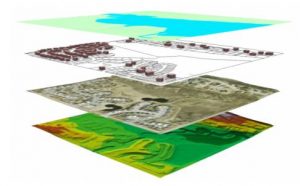GIS Data (Geographic Information Systems) uses, advantages and disadvantages
A geographic information system is commonly referred to as a GIS , It is an integrated set of hardware and software tools used to manipulate and manage the digital spatial ( geographic ) and related attribute data .
What is A GIS ?
A (GIS) is a computer-based tool for mapping , analyzing geographic phenomenon that exist & the events which occur on Earth , It integrates common database operations such as the query and the statistical analysis with the unique visualization and geographic analysis benefits offered by maps .
GIS Technology can capture all kinds of the geographical reference data as well as the digitally manipulating images from the Earth’s surface and it presents the data in a 3-D , The professionals and domain specialists are using GIS technology for addressing their unique spatial problems .
GIS Technology has superb abilities that distinguish GIS from the other information systems and make it valuable to a wide range of public and private enterprises for explaining the events , predicting the outcomes & planning strategies .
You know that Map making and geographic analysis are not new , but a GIS performs these tasks faster and with more sophistication than do traditional manual methods .
Geographic Information System is a multi-billion-dollar industry employing hundreds of thousands of people worldwide , It is taught in the schools , colleges , and universities throughout the world .
GIS technology provides the facilities for the data capture , data management , data manipulation & analysis and the results presentation in both the graphic and report form , with a particular emphasis upon preserving and utilizing inherent characteristics of spatial data .
GIS is used in conservation research , It offers better time management as finding the locations is almost instant , The collection of data is quicker with GIS and the location is more accurate if the signal can be found .
There are many data which can be displayed and inventoried with the use of GIS such as the natural resources , the wildlife , the cultural resources , the wells , the springs , the water lines , the fire hydrants , roads , the streams and houses .
GIS data and associated model output are as good as the remote sensing methods from which they are derived such as the aerial photographs , the satellite imagery , laser altimetry , the field surveys , digitizing , etc .
Advantages of GIS technology
Geographic Information Systems can visualize spatial information , It has the power to create the maps with the images shown , It can be used for a vast range of tasks involving geography , It can provide the solutions for the problems and it can model seismic activity precisely .
GIS technology offers time management , It offers quick collection of data , It presents catalog of data , It has high accuracy , It presents better predictions and analysis .
GIS improves the organizational integration , It can integrate the hardware , software and data for capturing , managing , analyzing and it can display all forms of geographically referenced information .
It allows us to view , understand , question , interpret & visualize the data in many ways that reveal relationships , patterns and trends in the form of maps , globes , reports and charts .
A GIS helps you answer the questions and solve the problems by looking at your data in a way that is quickly understood and easily shared , GIS technology can be integrated into any enterprise information system framework .
GIS data is used in the natural resource management that can include hillslope gradients , the aspects , the stream networks , the stream gradients , vegetation and the other watershed features and there is another type of GIS information which is vector (line) data such as the stream channels .
Disadvantages of GIS technology
Geographic Information System is very expensive software , It requires enormous amount of date inputs to be practical for some tasks , It makes it prone for error , It has relative loss of resolution and it has violation of privacy .
Geographic Information System signal needs to be found in remote areas , It is too heavily relied on , The geographic error is increased as you get into a larger scale as the earth is round , Funding for GIS is needed because it is more costly , there will be a loss of knowledge of geography .
GIS layers cause some costly mistakes when the property agents are to interpret the GIS map or the design of the engineer around the utility lines of the GIS , The data availability is a major issue , If the data is not available , then the GIS system is useless .
Disadvantages of using GIS are that its technical nature may portray results as being more reliable than they actually are and the errors and the assumptions can be hidden , leading to a lack of questioning into the results .
Another issue of analyzing the results from a GIS is that the results will only be as accurate as the data that they come from , So , the data may not be able to serve different contexts , particularly if the data is not applicable .
GIS technology is not like the other programs , It does not come off the shelf , So , they must be assembled and constructed to the user design , This could be a long , complex and costly process , So , Some GIS systems can fail in their implementation as their creation was rushed or inadequately planned .
GIS systems are so complex , the technology behind GIS technology expands rapidly, causing GIS systems to have a high rate of obsolescence , As GIS is relatively new , integrating GIS data with traditional maps is difficult .
It’s very hard to make GIS programs which are both fast and user friendly , GIS systems typically require complex command language , Data fields and their accessibility are not very understood and data can become incomplete , obsolete or erroneous , rendering the GIS misleading .














